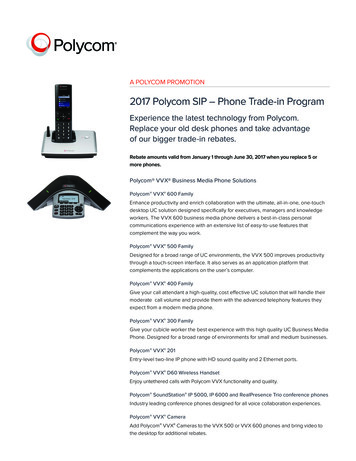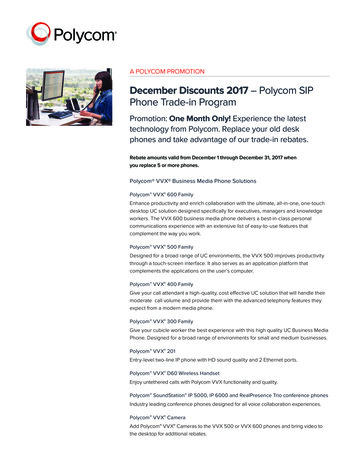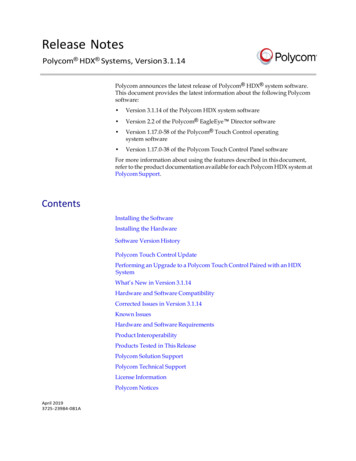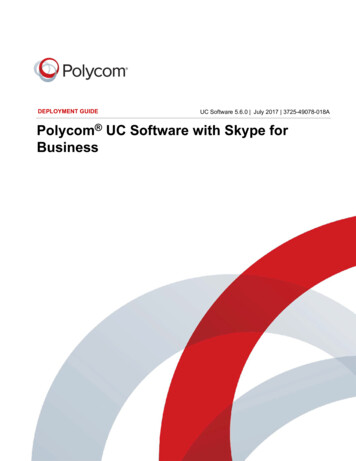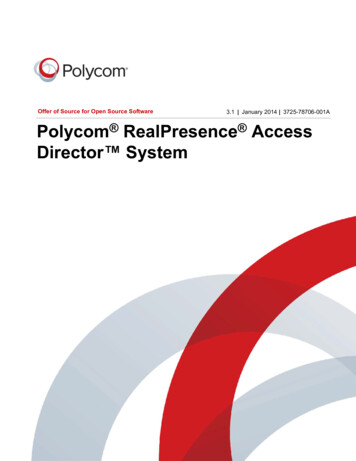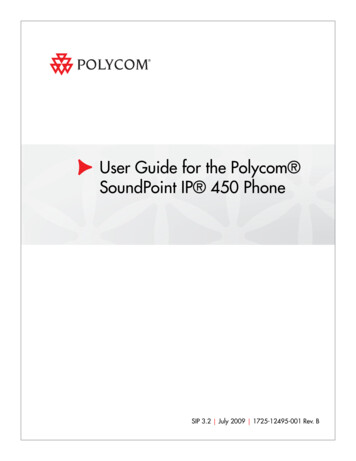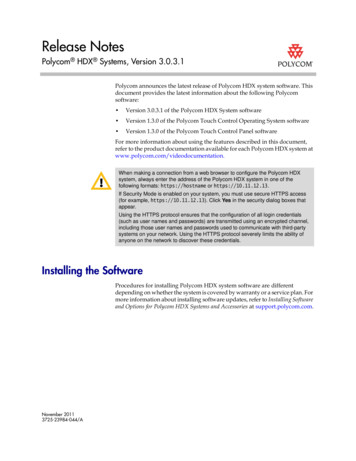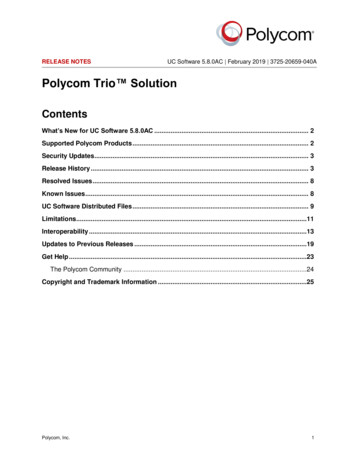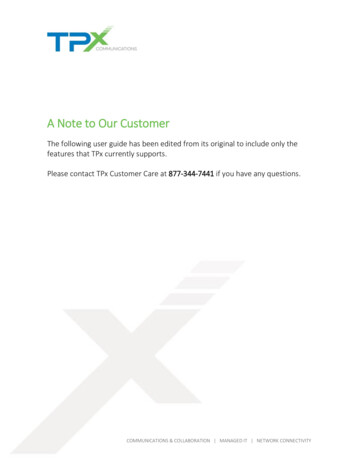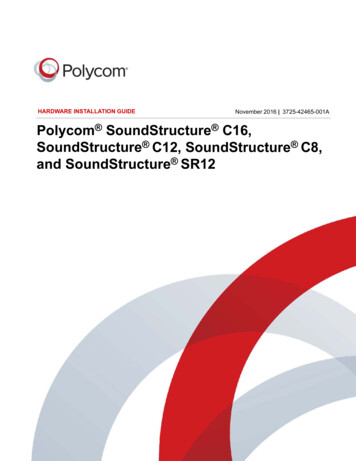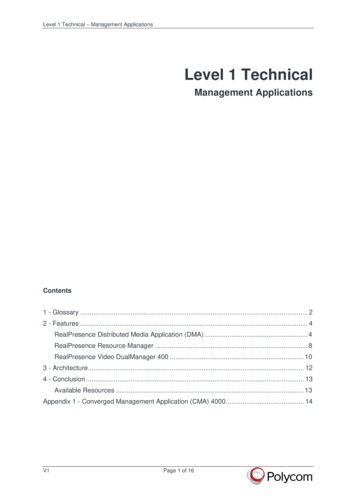
Transcription
Level 1 Technical – Management ApplicationsLevel 1 TechnicalManagement ApplicationsContents1 - Glossary . 22 - Features . 4RealPresence Distributed Media Application (DMA) . 4RealPresence Resource Manager . 8RealPresence Video DualManager 400 . 103 - Architecture. 124 - Conclusion . 13Available Resources . 13Appendix 1 - Converged Management Application (CMA) 4000 . 14V1Page 1 of 16
Level 1 Technical – Management Applications1 - GlossaryLevel 1 introduced three distinct learning paths which all converge when discussingtelepresence solutions. They are Polycom terminology for features and functions, technicalnetwork terminology which is used to detail how those features and functions work, and alsothe actual solutions themselves.We will develop each of these three paths further through each training level, but first we willrecap the key points covered so far which specifically apply to resource management andtake a look at what is coming up.Network terminology Call Admission Control – method of policing calls to make sure that no more thanthe allocated bandwidth is utilizedGatekeeper – device which provides Call Admission Control and which endpointsregister to enabling the use of E.164 aliases for simplified dialingGateway – Device which allows two incompatible protocols or areas of the networkto communicate. For example, H.320 (ISDN) requires a gateway to be in the sameconference as H.323 (IP). An internet gateway is used to traverse firewalls and movetraffic from the LAN to the internetH.323 – an open standard protocol used for videoconferencing over IP networksProxy – a device which takes data from one network and sends it to another, usuallyinvisibly to the userSIP – Session Initiation Protocol; an open standard protocol used forvideoconferencing over IP networksPolycom Management Applications solutions RealPresence Distributed Media Application (DMA) – a network-based videoconferencing solution that provides the following functionality:ooooo RealPresence Resource Manager – a network-based video conferencing solutionthat provides the following functionality:oooooo V1Conference Managemento Virtualization and load balancingCall Controlo Gatekeepero SIP registrar and proxy servero SIP / H.323 gatewayReportingIntegration into third party management and scheduling solutionsAvailable in hardware (appliance) format or software (virtual edition) formatEndpoint managementReportingSchedulingPresence engineIntegration into third party management and scheduling solutionsAvailable in hardware (appliance) format or software (virtual edition) formatRealPresence Video DualManager 400 – a network-based video conferencingsolution for small to mid-size customers that provides the following functionality:Page 2 of 16
Level 1 Technical – Management ApplicationsoooooooooV1Endpoint managementReportingSchedulingPresence engineConference ManagementCall ControlReportingIntegration into third party management and scheduling solutionsAvailable in hardware (appliance) format onlyPage 3 of 16
Level 1 Technical – Management Applications2 - FeaturesRealPresence Distributed Media Application (DMA)The hardware (appliance) form of RealPresence Distributed Media Application (DMA)utilizes the same server to the RealPresence Resource Manager and RealPresence VideoDualManager 400.RealPresence DMA licensing is managed by number of concurrent calls. A RealPresenceDMA out of the box provides licensing for 50 concurrent calls, and more can be added to inbundles of 50, 100, 500, 1000 or 5000.Before becoming a call control server (before the release of v3.0), the licensing for the DMAwas simply determined by how many MCUs were required. When upgrading aRealPresence DMA to v3 or higher, each RealPresence Collaboration Server (RMX) licensewill be converted to a license for 200 concurrent calls.Redundancy is available in two different ways. The first way of achieving redundancyconnects two servers with a crossover cable to create a dual-server cluster. Although eachRealPresence DMA maintains its own database, they are constantly replicating each otherand maintain the same state. In this configuration the RealPresence DMA dual-server clusterhas a virtual IP address which is used for GUI access, gatekeeper registration and so on,and each server still has its own real IP address if direct access is required. In this format upto 5,000 concurrent calls and 15,000 device registrations are available. Optional MicrosoftActive Directory integration is possible if required.The second redundancy method is where single servers and dual-server clusters are linkedto each other on the same network. Up to five servers and clusters can be linked in this way,which is known as a supercluster. A supercluster works the same way as the dual-servercluster, except that the database replication is performed across a network. In the event of acluster failure, another cluster will take over. In this format, up to 25,000 concurrent calls and75,000 device registrations are available.Single serverSuperclusterWANDual-server clusterThe software (virtual edition) format of RealPresence DMA is able to support the samecapacities as the appliance version with the appropriate server specification.V1Page 4 of 16
Level 1 Technical – Management ApplicationsSoftware KeysAs mentioned in Level 1, a software key is used to ‘unlock’ extra features should they berequired by the customer. Software keys for RealPresence DMA are available for thefollowing features: Single-server Upgrade (used to create a dual-server cluster)Upgrade to add 50 concurrent callsUpgrade to add 100 concurrent callsUpgrade to add 500 concurrent callsUpgrade to add 1000 concurrent callsUpgrade to add 5000 concurrent calls (appliance version only)Upgrade to allow access to API (Application Programming Interface) suite for thirdparty integration and managementVirtualization and load balancingThe primary conference management function of RealPresence DMA is to providevirtualization and load balancing services for all connected conference platforms. Supportedconference platforms (MCUs) are: RealPresence Collaboration Server seriesCisco TelePresence MCU 4000 SeriesCisco TelePresence MSE 8000 SeriesThe RealPresence DMA manages this by providing ad-hoc conferencing services throughthe use of virtual meeting rooms. Rather than all the MCUs holding individual meetingrooms, users dial into a RealPresence DMA virtual meeting room and the RealPresenceDMA finds an MCU to take the call. Instead of dialing the MCU E.164 alias followed by themeeting room ID, the user dials into the RealPresence DMA E.164 alias followed by thevirtual meeting room ID. This is shown very simply in the diagram below where theRealPresence DMA E.164 alias is 10.Dials 101000Dials 101000Dials 101005Dials 101005DMAStart a conference for theendpoints in VMR 1000Start a conference for theendpoints in VMR 1005As can be seen here, the RealPresence DMA becomes a virtual conference platform andcan place each call on the appropriate MCU to balance the load in a suitable manner. Thiscan be done in a number of ways using MCU ‘pools’ to determine which calls go where. Forexample, the above diagram can be amended to show a simple geographical MCU setup,the incoming calls will go to the nearest MCU, but in the event of a failure the other MCU canbe utilized if necessary.V1Page 5 of 16
Level 1 Technical – Management ApplicationsSydneyDials 101000SydneyLondonDials 101000Dials 101005LondonDMAStart a conference for theendpoints in VMR 1000Dials 101005Start a conference for theendpoints in VMR 1005If more than one MCU is required for any reason, the RealPresence DMA manages allnecessary hardware so that the end user is not aware of how the call has been connected.With Active Directory integration it is even possible to have the RealPresence DMA generateVMR numbers for every user automatically, so a VMR number will match each user’s phonenumber.In the same way that the RealPresence Collaboration Server uses profiles when meetingrooms are created, the RealPresence DMA also uses profiles so that it can explain to theRealPresence Collaboration Server exactly what is required when the call fires up. All of thisintelligence is performed ‘behind the scenes’ so that the end user does not know (or care)which MCU they are connected to, but no matter where they are connected from they will besure to join the right conference in the best manner possible.GatekeeperAt the foundation of the gatekeeper functionality is the capacity to configure a networkshowing sites and site links. From there, correctly configured, RealPresence DMA will knowwhen a call starts up in London trying to contact Sydney, whether there is adequatebandwidth available on the links in between to allow the call through.RealPresence DMA will also resolve the E.164 alias of an endpoint registered to it to routethe call correctly to the IP address of that endpoint.The gatekeeper has two ‘modes’ or methods of operation. These are known as direct modeor routed mode and differ in the management of the signaling traffic.In routed mode, one endpoint dials another, the call goes to RealPresence DMA, asRealPresence DMA decides where to route it. After resolving the destination address, themedia (audio/video) is sent directly from one endpoint to the other, but the signaling stillgoes through RealPresence DMA. This enables RealPresence DMA to manage theconnection for call admission control and reporting purposes:V1Page 6 of 16
Level 1 Technical – Management ApplicationsSignaling trafficSignaling trafficRealPresence DMAMedia trafficWhen using direct mode, although the initial signaling goes via RealPresence DMA, as soonas RealPresence DMA has resolved the alias and sent the call to the other endpoint, it dropsthe signaling and lets the endpoints take over. Although this method allows more concurrentcalls on RealPresence DMA (as in effect RealPresence DMA is doing less), it also meansthat RealPresence DMA cannot manage bandwidth or reporting as it has no furtherknowledge of the call:RealPresence DMAMedia trafficSignaling trafficIn addition to registering endpoints and infrastructure to it, RealPresence DMA gatekeepercan also support gatekeeper neighboring, where one gatekeeper is made aware of another,so that when a call comes in and the E.164 alias is not recognized it is first passed to allneighbors for resolution.RealPresence DMA also supports alternate gatekeeper settings, which is where thegatekeeper registrations will pass to a nominated alternate IP address in the event of afailure. It also supports prefix dialing, where a prefix is dialed followed by the E.164 alias toroute the call to a specific gatekeeper.The gatekeeper function can also be used to provide a global address book (GAB) whereActive Directory integration is not used; each endpoint which registers can be set to appear ifrequired for ease of dialing.Where a RealPresence Resource Manager is present in the network, the RealPresenceDMA can be ‘joined’ to the RealPresence Resource Manager solution in question, allowing itto share the sites, site links and other topographical information without the need to duplicatethe configuration manually.SIP registrar and proxy serverIt is common in a SIP environment to use a proxy (often referred to as just a SIP server) toenable simplified dialing. To compare at a high level, in H.323 you dial an IP address, orV1Page 7 of 16
Level 1 Technical – Management Applicationswhen registered to a gatekeeper, via E.164 alias. In SIP, without registration to a proxyserver you can also dial an IP address or via a SIP URI (Uniform Resource Identifier). A SIPURI has a format of username@SIP server, and the username could be letters or numbers,for example, if your SIP server is video.polycom.com and your username is johnsmith, yourSIP URI would be johnsmith@video.polycom.com. If you were using numbers and IPaddresses it might look something like 1000@140.242.6.100.However, when registered to a SIP server, you can dial without needing to add the SIPserver on the end, enabling dialing via username only.The registrar is a separate function (often hosted on the same server) which acts in a similarmanner to a DNS server, it records the location (IP address) of a SIP endpoint with theusername to assist with call setup.SIP / H.323 gatewayThe SIP / H.323 gateway supports calls between SIP and H.323 devices without the needfor an MCU. The RealPresence DMA will automatically first try to resolve the call using SIPor H.323 at both ends, and will only start a gateway session if there is no other way for thecall to proceedReportingSeveral reports are available on the RealPresence DMA, they are: Alert History – shows system alerts (can be filtered by date)Call History – shows details of each point to point call (can be filtered and exported)Conference History – shows details of each call using an MCU (can be filtered)Call Detail Records (CDRs) – shows call details records (can be filtered andexported)Registration History – shows details of each endpoint registration (can be filtered)Active Directory Integration – where Active Directory integration is configured,shows contact results for each domain in the forest and lists any which couldn’t becontacted (only a domain user can view this report)Orphaned Groups and Users – where Active Directory integration is configured,shows all users and groups which are no longer contactableConference Room Errors – where Active Directory integration is configured, showsall errors with regards to conference room numbering such as conflicts caused bynumber generation (only a domain user can view and export this report)Enterprise Passcode Errors – where Active Directory integration is configured,shows all errors with regards to passcode generation such as conflicts caused bynumber generation (only a domain user can view and export this report)Network Usage – shows bandwidth usage on sites and site links, including callstatistics showing average packet loss, jitter and delay (can be filtered and exported)RealPresence Resource ManagerThe hardware (appliance) version of RealPresence Resource Manager has an entry point of100 devices, but can provide registrations for up to 10,000 devices. In addition to this, theRealPresence Resource Manager has the ability to be clustered for redundancy in a similarway that RealPresence DMA does, using dual-server clusters directly linked to each otherand residing ‘behind’ a virtual IP address.RealPresence Resource Manager also supports integration into Active Directory andmulti-tenancy. This means that the available resources licensed within the server may beV1Page 8 of 16
Level 1 Technical – Management Applicationsseparated virtually, enabling a service provider or large enterprise to host different networkswith no access to the others unless specifically allowed.The software (virtual edition) format of RealPresence Resource Manager is able to supportthe same capacities as the appliance version with the appropriate server specification.Software KeysSoftware keys for RealPresence Resource Manager are available for the following features: Upgrade to add 100 licensesUpgrade to add 500 licensesUpgrade to add 1000 licensesUpgrade to add 2500 licensesUpgrade to add 5000 licensesUpgrade to add 100 licenses for service provider (multi-tenancy) environmentsUpgrade to add 500 licenses for service provider (multi-tenancy) environmentsUpgrade to add 1000 licenses for service provider (multi-tenancy) environmentsUpgrade to add 2500 licenses for service provider (multi-tenancy) environmentsUpgrade to add 5000 licenses for service provider (multi-tenancy) environmentsUpgrade to add 10000 licenses for service provider (multi-tenancy) environmentsUpgrade to allow access to API (Application Programming Interface) suite for thirdparty integration and managementHigh availability (used to create a dual-server cluster)Endpoint managementRealPresence Resource Manager can be used for a number of endpoint managementfunctions, from basic control via the GUI to upgrading endpoint software automatically. Theyare summarized here: Simple to use browser UI which can be used to find and manage each endpointSoftware update function can be used to push software to each endpoint individuallyor in groups, or can be used to automatically update at a scheduled timeProvisioning profiles can be created to provide a settings template for each endpoint.This can be automatically applied or it can be manually pushed out when requiredReportingSeveral reports are available on the RealPresence Resource Manager, they are: V1Report Considerations for Multi-tenancy – reports on specific Areas where multitenancy is in useSite Statistics – shows the status of each site in real timeSite Link Statistics – shows the status of each site link in real timeEndpoint Usage – shows the usage of each endpoint including hours in use,bandwidth used, time of dayConference Usage – shows the time, date and duration of conferencesConference Type – shows whether conferences were point to point or multipoint,scheduled or adhoc etc. (may be exported)View and Export System Log Files – shows all system log entries (may beexported)Page 9 of 16
Level 1 Technical – Management Applications Download Log Files – downloads a package including system log entries, hardwarestatus and other informationView and Download Audit Log Files (may be exported)Resource Manager System – produces a text file describing the systemconfigurationSchedulingPlease note direct scheduling using Management Application solutions is not connected withPolycom Conferencing for Outlook (PCO) in any way, and is a completely separate solutionwith a different value proposition. A conference scheduled directly is automatically dialed outat the appropriate time, and the RealPresence Resource Manager will try and connect allparticipants unless a participant is configured during the booking process as ‘dial in’.If any of the endpoints are in use or are not answered the call to that site will fail, as opposedto PCO which offers a dial-in model where each participant dials from wherever they areattending the meeting.When positioning scheduling with a customer, be very careful to position the correct solution,and if possible double check with a Solutions Architect or post-sales engineer prior tosuggesting one method over the other.Presence EngineRealPresence Resource Manager provides a presence engine, allowing compatible desktopand mobile solutions to not only be provisioned and managed on the server, but alsoprovides presence services to allow end-user visibility.Compatible Polycom products include RealPresence Mobile and RealPresence Desktop,which are fully featured H.323 and SIP clients.API (Application Programming Interface) IntegrationRealPresence Resource Manager comes complete with a full API suite for integratingscheduling and monitoring tasks with existing third party solutions. So should a customerhave already invested in a network management and monitoring solution, adding the APIlicense to the RealPresence Resource Manager will enable the customer to integrate thesolutions, avoiding the necessity for monitoring the Polycom solution separately.Note that the RealPresence Resource Manager does NOT include gatekeeper functionality;it must be used in conjunction with RealPresence DMA to provide a full call control andmanagement solution.RealPresence Video DualManager 400Although it shares the same server type, unlike RealPresence DMA and RealPresenceResource Manager, RealPresence Video DualManager 400 is only available in a hardware(appliance) version, and does not support redundancy. It is designed for small to midsizecustomers who require a cost-effective solution for their video environment management.It provides both the functionality of RealPresence Resource Manager, supporting up to 400devices, and the functionality of RealPresence DMA, supporting up to 150 concurrent calls.Software KeysSoftware keys for RealPresence Video DualManager 400 are available for the followingfeatures: V1Upgrade to add 100 devices to Resource Manager and 50 concurrent calls to DMAUpgrade to add 200 devices to Resource Manager and 100 concurrent calls to DMAPage 10 of 16
Level 1 Technical – Management Applications V1Upgrade to allow access to API (Application Programming Interface) suite for thirdparty integration and managementPage 11 of 16
Level 1 Technical – Management Applications3 - ArchitectureAs previously stated, all three hardware (appliance) versions of the Management Applicationsolutions share the same server type.They run on a Linux platform which is very secure and not susceptible to network threats orattacks, and have a 1RU rack-mountable chassis, complete with dual power supplies. Eachserver has two 146GB hard drives configured in a RAID-1 formation, which means that oneof the hard drives is used for data storage and the other automatically makes a completecopy of the first hard drive in case of failure or corruption. (RAID stands for RedundantArrays of Inexpensive Disks and there are a number of standards which have all been givena number for simple identification).V1Page 12 of 16
Level 1 Technical – Management Applications4 - ConclusionThis guide has provided an introduction to the Management Application solutions and howthey fit into the RealPresence Platform. Your next step following the qualifying assessmentwill be Level 2 Instructor-Led Training, where you will learn more about how to set up,configure and manage the individual components of this solution family.Available ResourcesIn addition to the information contained in this document, please also take a moment tofamiliarize yourself with the following resources available:Solution brochures s/telepresence te papers - http://www.polycom.com/products/resources/white papers/index.htmlCustomer success stories - htmlProduct documentation rt/us/support/network/index.html DMA Getting Started GuideDMA Operations GuideRealPresence Resource Manager Getting Started GuideRealPresence Resource Manager Operations GuideRealPresence Video DualManager Getting Started GuideInfrastructure solution matrix (registration to Polycom Connect required) V1From the homepage Resources Sales Tools Product Reference MatricesSelect NA (North America) or ROW (Rest of the World)Page 13 of 16
Level 1 Technical – Management ApplicationsAppendix 1 - Converged Management Application (CMA) 4000IntroductionAt the time of writing this product had been replaced by RealPresence Resource Managerand RealPresence Video DualManager 400. In order to ensure that information regardingthis product remains available while necessary, the equivalent information is printed here.OverviewConverged Management Application (CMA) – a network-based video conferencingsolution that provides the following functionality:oooooEndpoint managementReportingSchedulingPresence engineGatekeeperKey FeaturesThe CMA 4000 has an entry point of 100 licenses, but can provide registrations for up to 400devices registered concurrently and support up to 240 concurrent calls. It also supportsintegration into Active Directory.The CMA utilizes an internal SQL database for registration, call scheduling and networkdata, but integration with an external SQL Server is also possible for additional resilience.Software KeysSoftware keys are available for the following features: Upgrade to add 100 licensesOutlook schedulingLotus Notes scheduling plug-inEndpoint managementCMA can be used for a number of endpoint management functions, from basic control viathe GUI to upgrading endpoint software automatically. They are summarized here: Simple to use browser UI which can be used to find and manage each endpointSoftware update function can be used to push software to each endpoint individuallyor in groups, or can be used to automatically update at a scheduled timeProvisioning profiles can be created to provide a settings template for each endpoint.When the endpoint connects the CMA, this can be automatically applied, or it can bemanually pushed out when requiredReportingSeveral reports are available on the CMA, they are: V1Site Statistics – shows the status of each site in real timeSite Link Statistics – shows the status of each site link in real timeIP Call Detail Report – shows the detail of each IP call (can be filtered and exported)Endpoint Usage Report – shows the usage of each endpoint including hours in use,bandwidth used, time of dayPage 14 of 16
Level 1 Technical – Management Applications Conference Detail Report – shows the conference usage, whether conferenceswere point to point or multipoint, scheduled or adhoc etc.SchedulingPlease note direct scheduling using Management Applications is not connected withPolycom Conferencing for Outlook (PCO) in any way, and is a completely separate solutionwith a different value proposition. A conference scheduled directly is automatically dialed outat the appropriate time, and the CMA will try and connect all participants unless a participantis configured during the booking process as ‘dial in’.If any of the endpoints are in use or are not answered the call to that site will fail, as opposedto PCO which offers a dial-in model where each participant dials from wherever they areattending the meeting.There are three different methods of providing direct scheduling. The first is via the browserUI, which is the most straightforward and only requires a login account.The second is via an Outlook plug-in. This will work only up to Outlook 2003, and uses acalendar template which links into the CMA itself for booking.The third is via a Lotus Notes plug-in. This will only work on the default Lotus template, andadds a new option for meetings which can be selected by the user.Presence EngineCMA provides a presence engine, allowing compatible desktop and mobile solutions to notonly be provisioned and managed on the server, but also provides presence services toallow end-user visibility.Compatible Polycom products include CMA Desktop, Telepresence m100 (both nowreplaced), RealPresence Mobile and RealPresence Desktop, which are all fully featuredH.323 and SIP clients.GatekeeperAt the foundation of the gatekeeper functionality is the capacity to configure a networkshowing sites and site links. From there, correctly configured, the CMA will know when a callstarts up in London trying to contact Sydney, whether there is adequate bandwidth availableon the links in between to allow the call through.The CMA will also resolve the E.164 alias of an endpoint registered to it to route the callcorrectly to the IP address of that endpoint.The gatekeeper has two ‘modes’ or methods of operation. These are known as direct modeor routed mode and differ in the management of the signaling traffic.The CMA is set by default to routed mode and this is the recommended setting.In addition to registering endpoints and infrastructure to it, the CMA gatekeeper can alsosupport gatekeeper neighboring, where one gatekeeper is made aware of another, so thatwhen a call comes in and the E.164 alias is not recognized it is first passed to all neighborsfor resolution.The CMA also supports alternate gatekeeper settings, which is where the gatekeeperregistrations will pass to a nominated alternate IP address in the event of a failure.The gatekeeper function can also be used to provide a global address book (GAB) whereActive Directory integration is not used; each endpoint which registers can be set to appearfor ease of dialing.ArchitectureV1Page 15 of 16
Level 1 Technical – Management ApplicationsThe CMA runs on a Windows Server 2003 platform. The CMA has a 1RU rack-mountablechassis, complete with dual power supplies. It has one 72GB hard drive.Available roducts/telepresence etwork/index.html V1CMA Getting Started GuideCMA Operations GuidePage 16 of 16
RealPresence DMA licensing is managed by number of concurrent calls. A RealPresence DMA out of the box provides licensing for 50 concurrent calls, and more can be added to in bundles of 50, 100, 500, 1000 or 5000. Before becoming a call control server (before the release of v3.0), the licensing for the DMA


